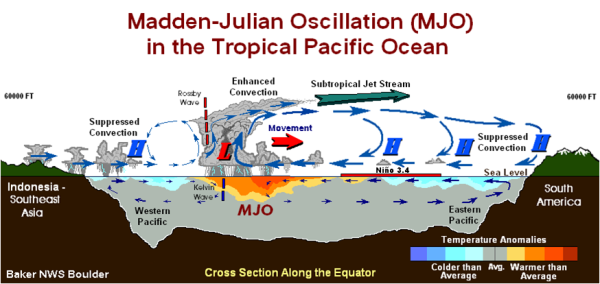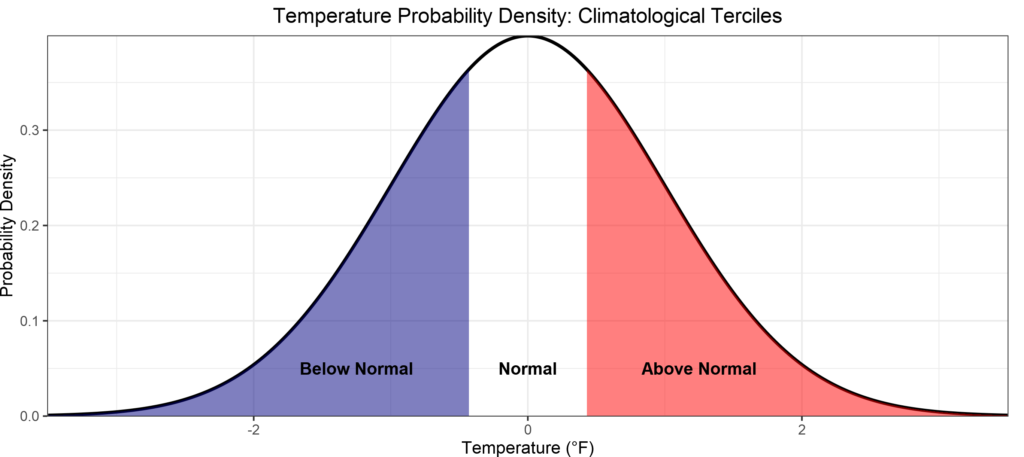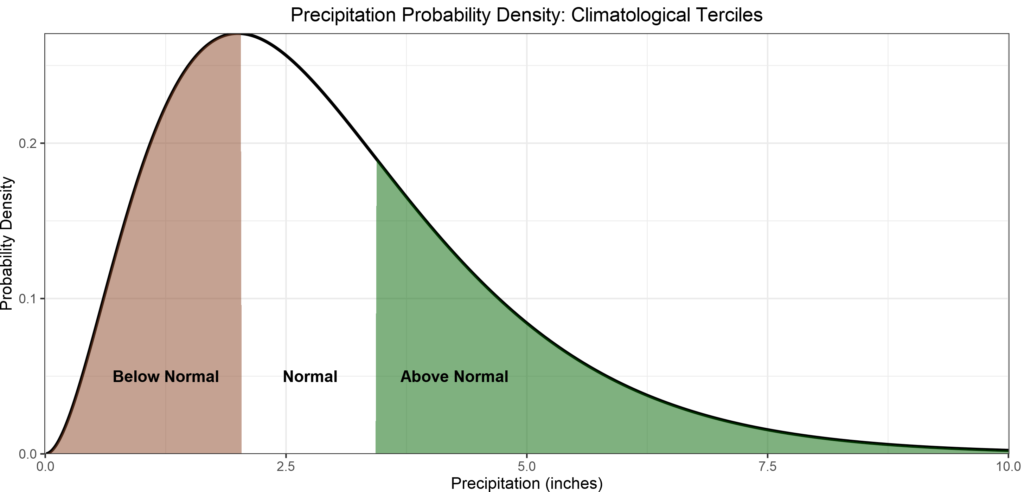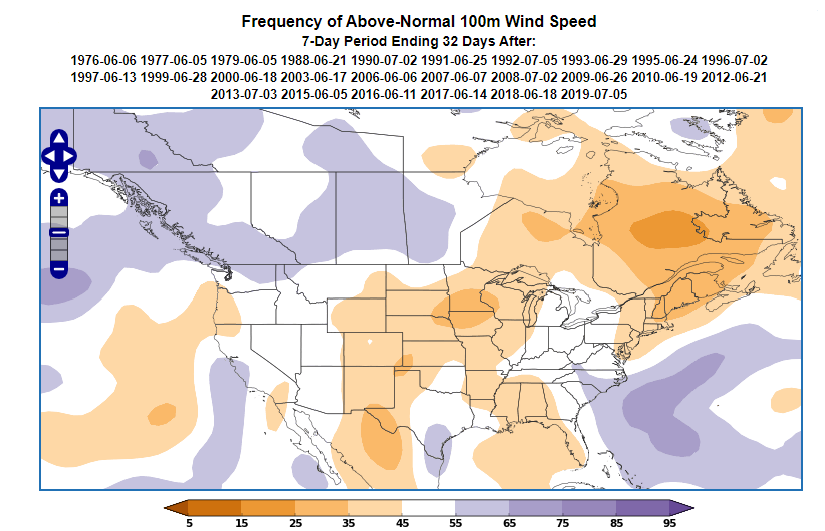It is 100 years since Lewis Fry Richardson first attempted to calculate a weather forecast using a technique now known as numerical weather prediction (NWP). However, the technique really took off in the second half of the 20th century at the dawn of the microprocessor era. Weather forecasting has made considerable strides in recent decades, so much so that it is now possible to produce tangible skill in forecasts with a lead time of three to six weeks or even more.
As forecasting skill improves at all lead times, new opportunities emerge to provide innovative and valuable services. Founded in 2009, the World Climate Service is positioned to be a leader in the exciting developments and upcoming growth of long-range weather and climate forecasting.
This post provides an introduction to long-range weather forecasts (also called long-lead weather forecasts) with links to additional information. We discuss:
Section 1 – Long-Range Weather Forecasts: Introduction
- The Long-Range Weather Forecast – a brief history
- Applications of Long-Range Weather Forecasts
- The Value of the Long-Range Weather Forecast
- Long-Range Weather Forecasts – Sources of Predictability
- Long-Range Weather Forecasts – Dynamical Models
- Long-Range Weather Forecasts – Index Analog Method
- Long-Range Weather Forecasts – Statistical Tools
- Long-Range Weather Forecasts – Energy Meteorologists
Section 2 – Ensemble long-range forecasting
- What is an ensemble forecast?
- What is the difference between deterministic and ensemble forecasts?
- What is a probability forecast?
- Anomaly versus probability forecast
- Subseasonal forecasting skill
- What is forecast calibration?
- What is forecast reliability?
7.1. See, for example, the reliability of NOAA Seasonal Outlooks - Why forecast calibration is crucial
Section 3 – Analog and Statistical Long-range Forecasting
- What is analog forecasting?
- What is a statistical forecast?
- What is the difference between a subseasonal and seasonal climate index?
- Why are Sea Surface Temperatures important?
- What is a Climate Index?
- What is the El Niño/Southern Oscillation (ENSO)?
- What is the North Atlantic Oscillation (NAO)?
- What is the Pacific Decadal Oscillation (PDO)?
- What is the Indian Ocean Dipole (IOD)?
- What is the Madden-Julian Oscillation (MJO)?
- What is the Arctic Oscillation (AO)?
- What is the Pacific North America Pattern (PNA)?
- What is the Scandinavian Pattern Climate Index (SCAND)?
- What is the Eastern Atlantic/Western Russia Pattern (EA/WR)?
- What is the Stratospheric Polar Vortex (SPV)?
- What is the Quasi-Biennial Oscillation (QBO)?
- What is the Eastern Pacific Oscillation (EPO)?
- What is the Western Pacific Oscillation (WPO)?
- What is the Atlantic Multi-decadal Oscillation (AMO)?
- What is the Northeast Pacific Mode (NPM)?
- What is the Tropical North Atlantic Index (TNA)?
- What is the Southern Angular Mode (SAM)?
The Long-Range Weather Forecast – a brief history
Founded in 1975 and funded by a consortium of European nations, the European Centre for Medium-Range Weather Forecasting (ECMWF) was the pioneer in long-range weather forecasting. In the 1980s, the ECMWF forecast model ran to 10 days ahead, but the advent of increased computing power in the ‘90s saw this horizon extended to 15 days.
The World Meteorological Organization (WMO) defines “medium range” as three to 10 days ahead, with the 10 to 30-day range known as the “extended” range. Finally, “long-range” is defined as 30 days to up to two years into the future. These definitions may need a refresh given the advances in long-range weather forecasting seen in the last decade. The subseasonal time scale was introduced by the ECMWF in 2013 and is now widely used to refer to the period that bridges the gap between the medium range and the seasonal range (see below). The ECMWF forecast model is likely the best long-range weather forecast model available.
| Forecast Lead Time Terminology | ||
|---|---|---|
| Terminology | WMO Standard | Industry Standard |
| Short Range | 1 hr – 3 days | 1 hr – 3 days |
| Medium Range | 3 – 10 days | 3 – 15 days |
| Extended Range | 10 – 30 days | |
| Subseasonal | 3 – 6 weeks | |
| Seasonal | 1 – 3 months | |
| Long-range | 30 days – 2 years | |
| Modelling Center | Model Acronym | Lead Time (days) | Execution Frequency | Included in WCS |
|---|---|---|---|---|
| NOAA | CFSv2 | 45 | Daily | Yes |
| NOAA | GEFS | 35 | Daily | Yes |
| ECMWF | ENS-E | 45 | Monday & Thursday | Yes |
| JMA | Global EPS | 33 | Wednesday | Yes |
| BoM | ACCESS-S | 45 | Daily | |
| ECCC | GEPS 6 | 32 | Thursday | |
| UKMET | GloSea6 | 60 | Daily |
As of June 2021, several global forecasting centers routinely produce forecasts that extend into the subseasonal timeframe.
The Role of Machine Learning in Long-Range Weather Forecasting
In just the last few years machine learning in weather forecasting has arisen as a significant new development. Machine learning will likely revolutionize the weather forecasting industry because forecasts can be created in mere seconds compared to the many hours it takes using traditional methods to computationally grind out the forecast calculations. Machine learning also hold the possibility of improving forecasts at all time frames by extracting non-linear relationships existing modeling method may not yet capture. The future is bright for machine learning in this field.
Applications of Long-Range Weather Forecasts
There are numerous societal and economic benefits from the application of long-range weather forecasts.
- Energy Trading and Gas and Electric Utilities: both energy supply and demand are intricately linked to weather variations. Any business involved in managing energy resources or responsible for the security of energy supply will have a keen interest in the long-range weather forecast. Long-range forecasts can be used to calculation variables such as gas-weigthed heating degree days or the composite weather variable, which is used for gas demand forecasting in the United Kingdom.
- Natural resources: the burgeoning global population means that careful management of natural resources such as water has never been more important. Water companies routinely use long-range weather forecasts to optimize their planning strategies.
- Agriculture: the long-range weather forecast enables farmers to take timely actions to manage their crops, optimize yield, and guard against disease.
- Engineering: many building operations are sensitive to adverse weather, and long-range weather forecasts are used as part of the planning process.
- Emergency planning: agencies charged with protecting life and property will have a keen interest in the long-range weather forecast, enabling them to prepare and have access to the necessary resources in the coming weeks and months.
- Locust Management: The UN FAO uses seasonal and subseasonal forecasts to monitor for condition conductive to locust outbreaks. In fact, the UN FAO is a World Climate Service customer.
- Early Warning System: As long-range weather forecasts and related climate improves, medium range, subseasonal, and seasonal forecasts systems are being used as climate early warning system. These system endeavor to provide as much advanced warning of disruptive weather and climate events as possible. Jamaica recently experience drought, and turned to the World Climate Service as their early warning system.
The Value of the Long-Range Weather Forecast
Since the earliest days of weather forecasting, deterministic forecasts have been used to aid a wide range of business and decision-making. Weather forecast skill has increased over the decades making them more valuable and used in an ever-greater number of applications. For example, today’s smartphone weather applications to keep people abreast of weather events and developments is a hotly contested business segment. The same is happening with subseasonal and seasonal forecasts. As the science of long-range forecasts is better understood, the skill of the forecasts improves. This results in deeper penetration of long-range forecasts into business and even personal decision-making.
The World Climate Service is used today primarily by meteorologists in energy trading markets such as electricity and natural gas. Meteorologists advise traders regarding opportunities that may arise from subseasonal and seasonal probabilistic temperature, degree day, wind, and solar forecasts. Because weather conditions are a significant cause of both energy demand and generation, improved foresight of upcoming weather events provides opportunities to arbitrage prices in energy markets. The long-range forecasting and analysis provided by the World Climate Service have become a valuable tool to our customers.
The adoption of weather forecasts into society has been remarkable. Further development of long-range forecasting technology and applications generally and within the World Climate Service, will continue to improve their skill while making them more applicable in a wide range of applications. We at the beginning of a long process to understand the value of long-range forecasts.
Long-Range Weather Forecasts – Sources of Predictability
Traditional medium-range weather forecasting is an atmospheric initial value problem – in other words, if we know the initial state of the atmosphere all over the globe, then we can use weather forecast models to predict the future. That weather forecast model is a set of equations that describes the behavior of the atmosphere.
Long-range weather forecasting, on the other hand, relies more on the predictability offered by boundary conditions. Example boundary conditions include the temperature of the ocean surface and the extent of ice surfaces that are in contact with the atmosphere. These boundary conditions influence the atmosphere over weeks to months, with the ocean being the most important. Thus a component of long-range forecasting is sometimes considered to be an oceanic initial value problem.
Therefore, long-range dynamical models must be coupled ocean-atmospheric models, meaning that the modeled ocean and atmosphere communicate with each other. For example, one of the most important phenomena in the subseasonal timescale is the Madden-Julian Oscillation (Cassou 2008), a convective wave in the tropical atmosphere that is affected by the underlying ocean temperatures.

Other sources of long-range predictability include the state of the stratosphere (Baldwin and Dunkerton 2001) and the quantity of moisture in near-surface soils (Koster et al. 2010).
Long-Range Weather Forecasts – Dynamical Models
As discussed earlier, the most well-known method for producing a long-range weather forecast is the same dynamical (or computer) modeling used for traditional shorter-range weather forecasting. However, this is a costly method requiring supercomputers to represent the global ocean-atmospheric system and simulate all of the natural processes that drive the evolution of weather and climate. Another demanding requirement is that multiple concurrent forecasts are required – this ensemble method is vital in accounting for the uncertainty in the initial conditions.
The skill of the long-range weather forecast is generally low compared to the more familiar short-range weather forecast, and the output is not always clear to understand or easy to utilize. Still, there are valuable levels of skill found at different locations and various times of the year. Capturing the available signal typically requires forecasts to be presented as averages for weeks or months, rather than the spot values seen in short-range forecasts. Often forecasts are presented as probabilities for each of a number of percentiles or ranges of possible outcomes. The World Climate Service (WCS) frames the long-range forecast in terms of the probabilities of the above/normal/below (ANB) terciles.
The distribution of observations of temperature is approximately normally distributed. In this case, the ANB terciles are defined by using equally likely 33.33 percent portions of its normal distribution to define the ANB categories. The normal diagram below illustrates the construction of the tercile categories. Over a long period of time, each category is equally likely with a 33.33 percent likelihood. The role of long-range forecasting is to predict changes to this climatological distribution.

What if a variable is not normally distributed? Precipitation, for example, generally behaves as a gamma distribution. The World Climate Service long-range forecasting technology enables tercile forecasts of variables that have non-normal distributions. A hypothetical weekly-averaged precipitation distribution and the tercile segmentation into equal probability bins are shown below.

Long-Range Weather Forecasts – Index Analog Method
A less well-known yet often equally skillful forecasting technique is known as the index analog method. There are a number of climate indices (also known as climate cycles or drivers) at work around the world, and each displays a level of persistence and thus predictability. Moreover, the weather in one location is often coincident with another type of weather (often the opposite) in another location – this phenomenon is referred to as a teleconnection.
This forecasting approach does not require a supercomputer but rather knowledge of the current state of a climate index and the historic records for that index. We look to the past to see what typically happens when the climate index is positioned in a particular phase. The WCS provides powerful data mining tools allowing users to quickly determine the impacts of various climate indices at various times of the year all over the world. The analog tool output frames the result in terms of the frequency of conditions being above or below normal rather than tercile probabilities.

Long-Range Weather Forecasts – Statistical Tools
Statistical forecast tools are closely related to the index analog method of forecasting. However, unlike the analog method, a statistical forecast uses an automated approach to find a purely statistical relationship between weather conditions over recent months or weeks and future conditions. The model is trained using a long history of weather and climate conditions to automatically predict the future.
The application of machine learning and artificial intelligence techniques is emerging as an important statistical forecasting method. As these tools become better and historical datasets become longer, long-range statistical forecasting will likely emerge as an equally valuable complement to dynamical and analog methods.
Long-Range Weather Forecasts – Energy Meteorologists
More than ever, energy meteorologists rely on long-range weather forecasts and tools to understand the evolution of weather patterns and communicate the probabilities and various scenarios for energy supply and demand. The WCS provides an unparalleled suite of calibrated forecasts and analog tools, enabling energy meteorologists to quickly and accurately cut through the daily mountain of weather data.
References
Baldwin and Dunkerton, 2001. Stratospheric Harbingers of Anomalous Weather Regimes.
Cassou, 2008. Intraseasonal interaction between the Madden-Julian Oscillation and the North Atlantic Oscillation.
Koster et al., 2010, Contribution of land surface initialization to subseasonal forecast skill: First results from a multi-model experiment.